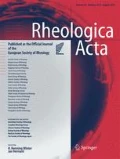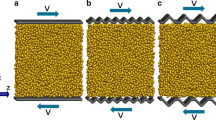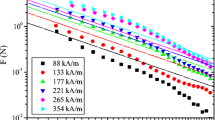Abstract
The non-linear properties of iron based magneto-rheological (MR) fluids are investigated at low magnetic field strengths (0–1.7 kA/m) and different gap thickness (0–500 μm) in a plate-plate configuration. Single-width chain models qualitatively predict the low-shear flow behavior when plotting the field-specific viscosity, η F , as a function of the Mason number, Mn: a slope close to −1 is observed in log-log representations. Wall depletion effects are observed when the suspensions are sheared under the presence of low external magnetic fields applied and/or large gap distances. These results are correlated to frictional yield stress measurements and chain length distribution calculations in the presence of the external magnetic field. Finally, an equivalent slip layer thickness is calculated using the method of Yoshimura and Prud’homme.







Similar content being viewed by others
References
Barnes HA (1995) A review of the slip (wall depletion) of polymer solutions, emulsion and particle suspensions in viscometers: its cause, character, and cure. J Non-Newtonian Fluid Mech 56:221–251
Cutillas S, Meunier A, Lemaire E, Bossis G, Persello J (1996) Phase separation and turbidity of electrorheological fluids. Int J Mod Phys B 10(23/24):3093–3101
de Gans BJ, Hoekstra H, Mellema J (1999) Non-linear magnetorheological behaviour of an inverse ferrofluid. Faraday Discuss 112:209–224
de Gans BJ, Duin NJ, van den Ende D, Mellema J (2000) The influence of particle size on the magnetorheological properties of an inverse ferrofluid. J Chem Phys 113(5):2032–2042
de Vicente J, Bossis G, Lacis S, Guyot M (2002) Permeability measurements in cobalt ferrite and carbonyl iron powders and suspensions. J Magn Magn Mater 251(1):100–108
de Vicente J, López-López MT, González-Caballero F, Durán JDG (2003) A rheological study of the stabilization of magnetizable colloidal suspensions by addition of silica nanoparticles. J Rheol 47(5):1093–1109
Goodwin JW, Markham GM, Vincent B (1997) Studies on model electrorheological fluids. J Phys Chem B 101:1961–1967
Goshawk JA, Binding DM, Kell DB, Goodacre R (1998) Rheological phenomena occurring during the shearing flow of mayonnaise. J Rheol 42(6):1537–1553
Halsey TC, Martin JE, Adolf D (1992) Rheology of electrorheological fluids. Phys Rev Lett 68(10):1519–1522
Klingenberg DJ, Zukoski CF (1990) Studies on the steady shear behavior of electrorheological suspensions. Langmuir 6:15–24
Larson RG (1999) The structure and rheology of complex fluids. Oxford University Press, Oxford
Marshall L, Zukoski CF, Goodwin JW (1989) Effects of electric fields on the rheology of non-aqueous concentrated suspensions. J Chem Soc Faraday Trans I 85(9):2785–2795
Martin JE, Anderson RA (1996) Chain model of electrorheology. J Chem Phys 104(12):4814–4827
McLeish TCB, Jordan T, Shaw MT (1991) Viscoelastic response of electrorheological fluids. I. Frequency dependence. J Rheol 35(3):427–448
Osipov MA, Teixeira PIC, Telo da Gama MM (1996) Structure of strongly dipolar fluids at low densities. Phys Rev E 54:2597–2609
Parthasarathy M, Klingenberg DJ (1996) Electrorheology: mechanisms and models. Mater Sci Eng 17:57–103
Phulé PP, Ginder JM (1998) The materials science of field-responsive fluids. MRS Bull August 19–22
Rankin PJ, Ginder JM, Klingenberg DJ (1998) Electro- and magneto-rheology. Curr Opin Colloid Interface Sci 3:373-381
Volkova O, Bossis G, Guyot M, Bashtovoi V, Reks A (2000) Magnetorheology of magnetic holes compared to magnetic particles. J Rheol 44(1):91–104
Yoshimura AS, Prud’homme RK (1987) A comparison of techniques for measuring yield stresses. J Rheol 31(8):699–710
Yoshimura AS, Prud’homme RK (1988) Wall slip corrections for Couette and parallel disk viscometers. J Rheol 32(1):53–67
Acknowledgements
Financial support by Ministerio de Ciencia y Tecnología (Spain) and FEDER funds (EU) under project MAT2001-3803 is gratefully acknowledged. Dr. D. van den Ende and Prof. J. Mellema from the Institute of Mechanics, Processes and Control, University of Twente, The Netherlands, are thanked for helpful discussions.
Author information
Authors and Affiliations
Corresponding author
Rights and permissions
About this article
Cite this article
de Vicente, J., López-López, M.T., Durán, J.D.G. et al. Shear flow behavior of confined magnetorheological fluids at low magnetic field strengths. Rheol Acta 44, 94–103 (2004). https://doi.org/10.1007/s00397-004-0383-6
Received:
Accepted:
Published:
Issue Date:
DOI: https://doi.org/10.1007/s00397-004-0383-6




